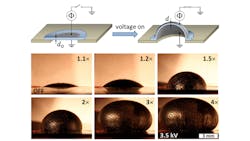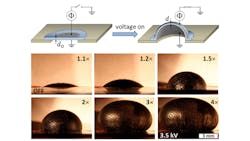Freestanding Dielectric Elastomers Offer New Capabilities in Actuation, Soft Robotics
Dielectric elastomers are researched for use in artificial muscles, soft robotics, and medical actuators. Made up of dipolar molecules that align with an electric field, they can expand or shape-shift in response to an applied voltage. A dielectric elastomer from North Carolina State University, Raleigh, is enhanced with electroactive "bottlebrush" polymers that allow it to deform under relatively low electric fields. The polymers also enable the elastomer to hold its final shape after the field is removed. The team's work is published in Advanced Materials and received funding from the National Science Foundation.
via GIPHY Dielectric elastomers can be used in soft actuators like artificial muscles that tighten or lengthen in response to an applied voltage. (Courtesy of Soft Robotics Toolkit, Youtube)
While dielectric elastomers usually require an external structure, such as a frame or support, to keep their shape after the electric field is turned off, the enhanced elastomer from NCSU is freestanding. As illustrated below, the bottlebrush polymers added to the elastomer have long sidechains that cause them to act almost like microscopic Velcro. The side chains intertwine with one another and do not so easily unravel so that they elastomer can keep its shape after activation. In addition, they are thick, but quite flexible, so they actually reduce the elastomer's overall stiffness without the need for liquid fractions or other materials that could alter the elastomer's electrical response and freestanding capabilities.
The electroactive bottlebrush polymers also significantly reduce the electric field strength needed to activate the elastomer. Dielectric elastomers usually require electric fields on the order of 100 kV/mm to expand. However, the team saw expansion with electric fields on the order of 10 kV/mm in their circular sample (left).
The bottlebrush elastomers were synthesized by grafting long polymer side chains onto a polymer backbone. By altering the grafting methods, the scientists could produce various degrees of polymerization and densities to affect the mass mechanical properties and stiffness of the elastomer.
While more research is still needed to determine the applicability of the material, a freestanding dielectric elastomer could stand out in the medical industry for applications like permanent stents or other implants. “We’re at the earliest stages of identifying all the potential ways in which we could use this new class of material,” says Richard J. Spontak, co-author of the paper and distinguished professor of chemical and biomolecular engineering and professor of materials science and engineering at NC State. “It works better than anticipated, and now we’re beginning to consider potential applications.”
About the Author
Leah Scully
Associate Content Producer
Leah Scully is a graduate of The College of New Jersey. She has a BS degree in Biomedical Engineering with a mechanical specialization. Leah is responsible for Machine Design’s news items that cover industry trends, research, and applied science and engineering, along with product galleries. Visit her on Facebook, or view her profile on LinkedIn.



